If you’ve ever wondered whether our planet hosts jumping bugs, look no more! We’ve compiled a list of commonly found bugs that can jump.

Keep reading to learn some incredible facts about them!
1. Fleas

Fleas are the insects in the
Siphonapteraorder, consisting of 2,500 parasitic insect species that live on the bodies of mammals and birds.
©iStock.com/S.Rohrlach
| Fleas | |
|---|---|
| Scientific name | Siphonaptera (order) |
| Description | Dark-colored, wingless insects measuring 0.06 – 0.12 inches long |
| Jumping possibilities | Can jump 50 times their body length |
| Another unique feature | Fleas have simple eyespots with biconvex lens; some species don’t have eyes at all. |
Fleas are insects in the Siphonaptera order, consisting of 2,500 parasitic insect species that live on the bodies of mammals and birds.
These bugs have excellent jumping skills and are among the best animal jumpers! They can jump up to 7 inches vertically and 13 inches horizontally.
On average, they can jump 50 times their body length. However, if needed, fleas can jump more than 100 times their length, equivalent to a human jumping vertically around 250 feet and horizontally roughly 450 feet!
These bugs have long legs, and the hind pair of legs is what aids them in jumping. However, while other insects rely on muscle power for jumping, fleas rely on the muscle energy stored in a resilin (an elastic protein) pad. Before jumping, the muscles contract, deform the resilin pad, and rapidly release the energy needed to sustain leg extension.
2. Ants

Jack jumper ants are known to have excellent jumping skills.
©iStock.com/Kevin Wells
| Ants | |
|---|---|
| Scientific name | Formicidae |
| Description | Most species are red or black and measure between 0.03 to 2 inches long. |
| Jumping possibilities | Often jump during foraging or if they feel agitated |
| Another unique feature | They have two antennae attached to their heads that help detect air currents, vibrations, and chemicals. |
Ants do not have wings, so they cannot fly. Most of them travel by walking. Some species, however, have developed their jumping skills. The Harpegnathos saltator, commonly called Jerdon’s jumping ant, synchronizes its mid and hind pairs of legs to jump.
Another ant species known to have excellent jumping skills is the jack jumper ant, scientifically called Myrmecia pilosula. These insects also go by the names “hopper ants,” “jumping jacks,” “jack jumpers,” and “jumper ants.” Jack jumper ant males and workers are roughly 0.43-0.55 inches long, while the queen is 0.55-0.63 inches long. They often jump during foraging or if they feel agitated. The ants in the Myrmecia genus also exhibit this behavior. If you ever want to spot a jumping ant, look for them during the day, as jumping jacks are primarily active when the sun’s up.
3. Lacewings

Lacewings are insects in the
Chrysopidaefamily.
©iStock.com/Pavel Abramov
| Lacewings | |
|---|---|
| Scientific name | Chrysopidae (Family) |
| Description | Green to greenish-brown insects with golden compound eyes and translucent wings |
| Jumping possibilities | Jump through simultaneous propulsive movements made by two pairs of legs |
| Another unique feature | The tympanal organs on the base of their forewings provide them with excellent hearing. |
Lacewings are insects in the Chrysopidae family. These insects are small, with a wingspan of 0.2-2.55 inches, but they have a unique, vibrant appearance! They are either crepuscular or nocturnal and feed on nectar, pollen, honeydew, and small arthropods.
Although their legs are shorter than their bodies, lacewings are capable jumpers! A study shows that brown and green lacewings jump through simultaneous propulsive movements made by their middle and hind legs. This makes them unique among other jumping insects; unlike lacewings, most bugs jump with the help of a single pair of legs.
4. Treehoppers

Treehoppers are part of the
Membracidaefamily.
©1,970 × 1,478 pixels, file size: 1.91 MB, MIME type: image/jpeg – License
| Treehoppers | |
|---|---|
| Scientific name | Membracidae (family) |
| Description | Vertical faces, elflike appearance; green, blue, and bronze colors, often featuring patterns with stripes or spots. |
| Jumping possibilities | Have specialized muscles on the hind femora that produce power for jumping |
| Another unique feature | Have enlarged, ornate pronotum (the foremost of the three thorax segments) |
Treehoppers, precisely typical treehoppers, are part of the Membracidae family. These insects are related to leafhoppers and cicadas and can be found worldwide except in Antarctica. Their enlarged and ornate thorax can easily distinguish treehoppers from other insects. Moreover, they have vibrant colors that make them easy to spot in the wild.
Besides being of great interest to scientists, thanks to their unique pronotum, treehoppers have another distinctive feature – the specialized muscles that help them jump! A treehopper’s “jumping muscles” are located on its hind femora. They unroll before jumping to provide the insect with enough power to leap.
5. Crickets
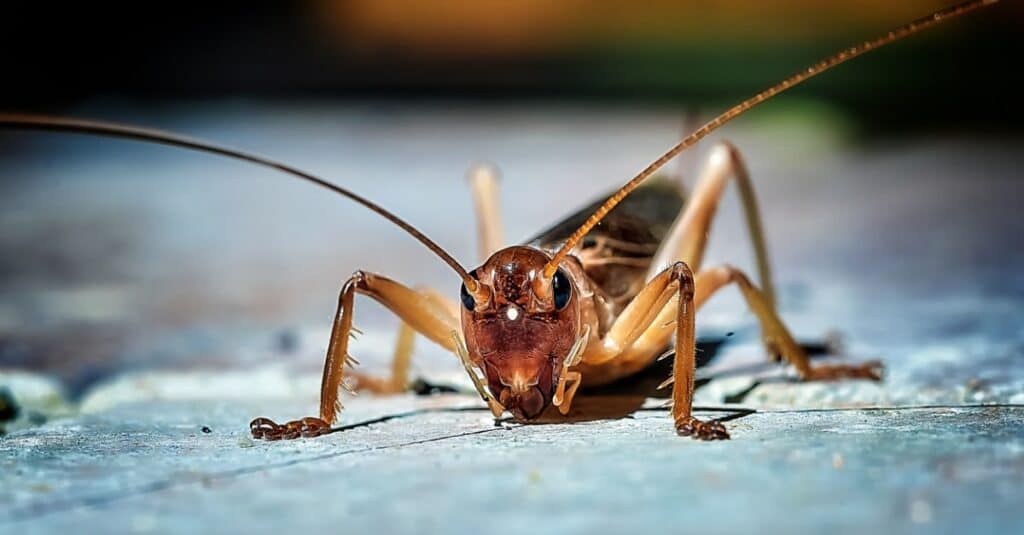
Crickets are small insects with cylindrical bodies, long antennae, and small heads.
©iStock.com/tracielouise
| Crickets | |
|---|---|
| Scientific name | Grylloidea (superfamily) |
| Description | Cylindrically-shaped bodies, long antennae, round heads, smooth and robust pronota |
| Jumping possibilities | The hind legs are enlarged to allow jumping |
| Another unique feature | Crickets can grow more legs |
Crickets form the Grylloidea superfamily. They are small insects with cylindrical bodies, long antennae, and small heads. The largest crickets are around 2 inches long. Their wings lie flat on their bodies and differ in size depending on the species. Some crickets lack wings altogether.
The enlarged femora (thigh bones) in their hind legs promote better jumping skills and power.
Some species living on the beach have developed their running and jumping skills to such an extent that they can now jump over the water’s surface! Besides this, crickets have the unique ability to grow more legs if needed!
6. Thrips
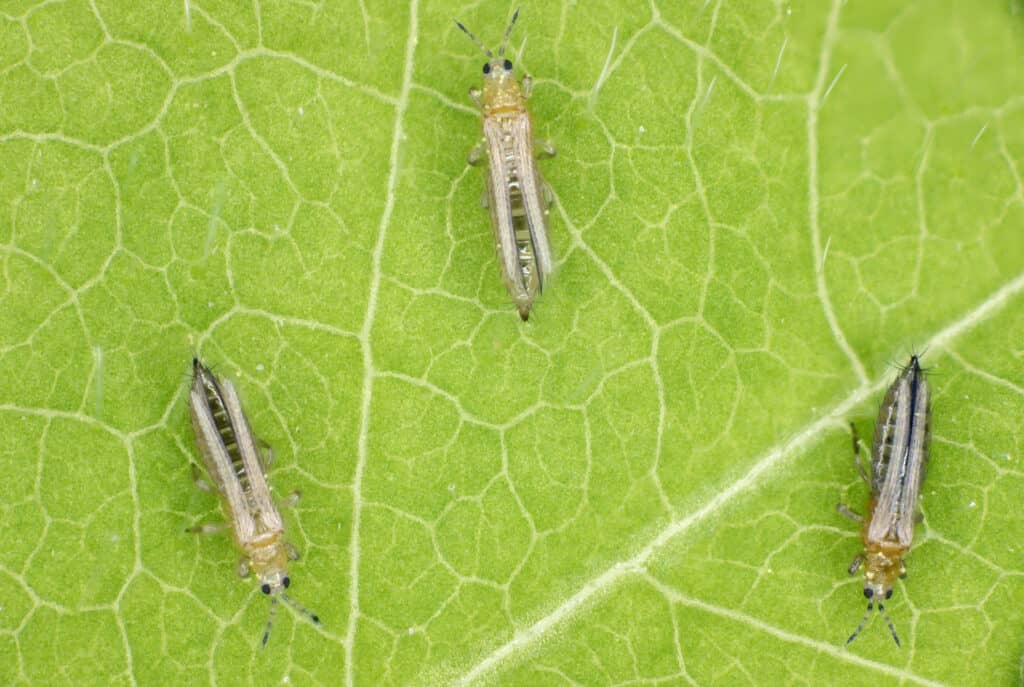
Thrips are small insects with slender, elongated bodies.
©iStock.com/Tomasz Klejdysz
| Thrips | |
|---|---|
| Scientific name | Thysanoptera (order) |
| Description | Small insects with two pairs of wings folded back over their bodies; some males are larger than females. |
| Jumping possibilities | They have small, light bodies that allow them to crawl, walk, or jump |
| Another unique feature | They have asymmetrical mouthparts |
Thrips are small insects with slender, elongated bodies. Their size ranges between 0.02 and 0.55 inches, the largest thrip being a species in the Phlaeothripidae family. Although they have wings, thrips aren’t great fliers, as their feathered wings aren’t adapted for conventional flight.
These insects are believed to jump, although they’re so small that it’s almost impossible to spot them jumping! That’s probably one of the reasons why many species are pests of commercial crops, while others are vectors for over 20 viruses that can make plants sick! However, beneficial thrips exist, too! Some species serve as pollinators and help control the mite population.
7. Grasshoppers
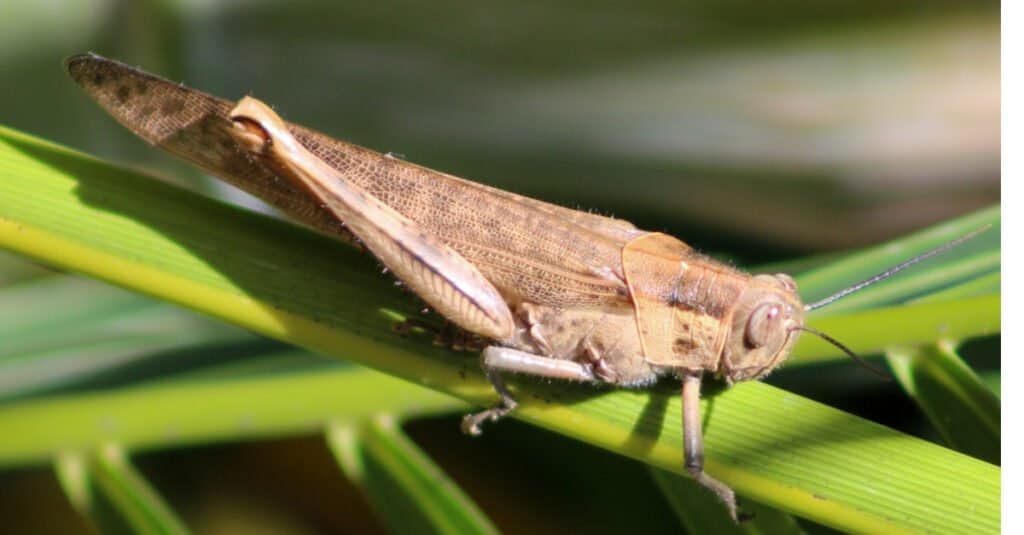
Grasshoppers possess two antennae that are sensitive to smell and touch.
©Cassandra Madsen/Shutterstock.com
| Grasshoppers | |
|---|---|
| Scientific name | Informal group Acridomorpha in the Caelifera suborder |
| Description | Have a pair of large compound eyes, three simple eyes, and a pair of antennae |
| Jumping possibilities | Can jump distances of up to 3.2 feet |
| Another unique feature | Have tympanal organs in the first segment of the abdomen that helps them hear |
Grasshoppers form an informal group of insects in the Caelifera order. They have a thorax and an abdomen. Their mouths are located at the bottom of their heads, and they have a pair of large compound eyes that help them see everything around them. Besides this, grasshoppers possess three simple eyes that help detect dark and light, as well as two antennae that are sensitive to smell and touch.
Grasshoppers are excellent jumpers! They use this ability to help themselves launch into flight, to move from one place to another, or to escape predators. Before jumping, grasshoppers extend their back legs, push against the ground (grass or anything else they stand on), and jump! Large insects can jump as far as about 3.2 feet! That’s 20 times their body length. And they don’t even use their wings!
8. Leaproaches
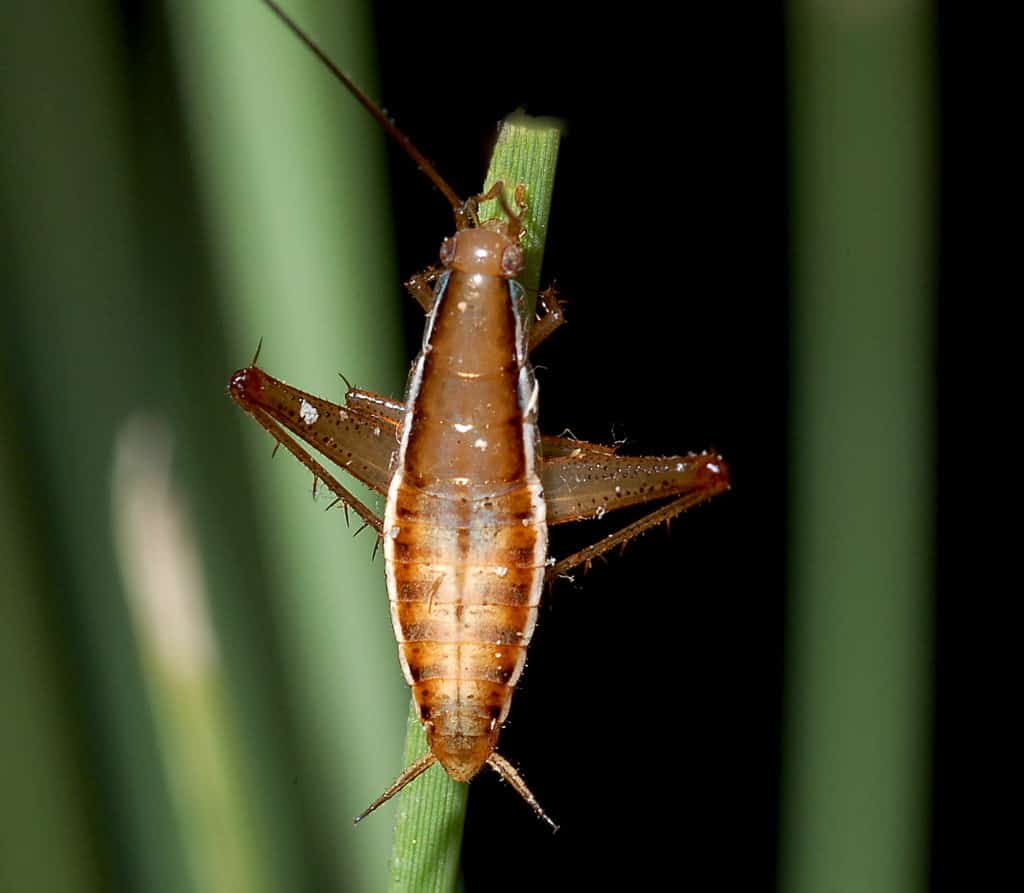
Leaproaches live only on the flat-topped Table Mountain near Cape Town.
©Mike Picker / CC BY-SA 4.0 – License
| Leaproaches | |
|---|---|
| Scientific name | Saltoblattella montistabularis |
| Description | Small cockroaches with brown-yellowish bodies |
| Jumping possibilities | Have enlarged hind legs that provide jumping power |
| Another unique feature | They are the only cockroaches that can jump |
Saltobatella montistabularis insects are known among researchers as leaproches. However, scientifically speaking, they are jumping cockroaches in the Blattodea family of cockroaches.
Leaproaches live only on the flat-topped Table Mountain near Cape Town and are the only ones among 4,000 cockroach species with jumping abilities, hence their nickname!
Unlike other cockroaches, leaproaches have enlarged hind legs that help them perform jumps similar to those of grasshoppers.
These jumping cockroaches are about 0.25-0.39 inches long and have brownish-yellowish bodies.
9. Jumping Plant Lice
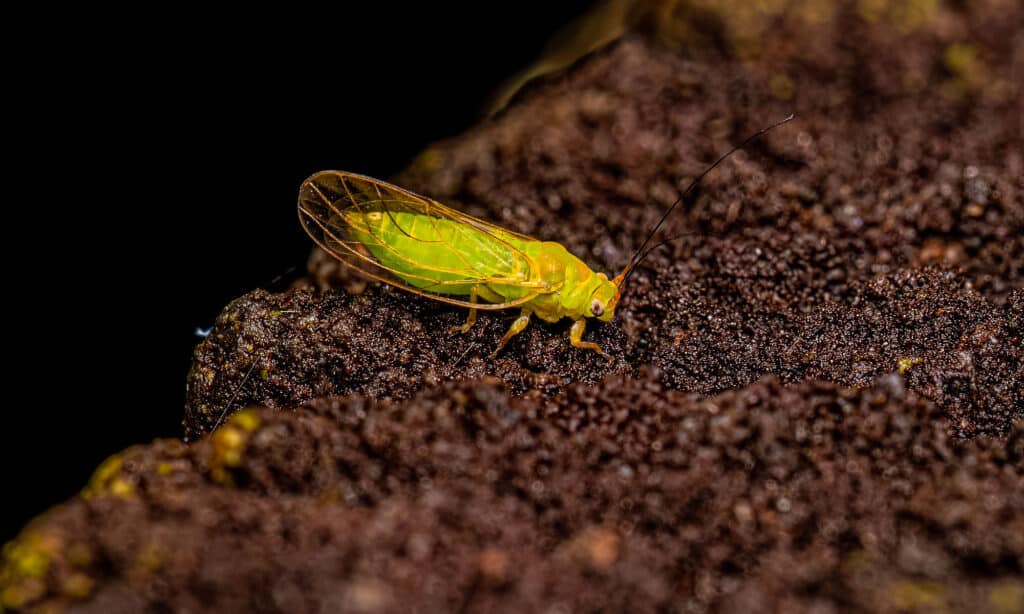
Jumping plant lice are small insects that feed on plants.
©Vinicius R. Souza/Shutterstock.com
| Jumping Plant Lice | |
|---|---|
| Scientific name | Psyllidae (family) |
| Description | Thin, needle-like mouthparts, brownish in color |
| Jumping possibilities | Have small hind legs that provide great jumping power |
Jumping plant lice are also called psyllids. They are small insects that feed on plants. Psyllids are considered pests as they can destroy and kill plants, although they aren’t difficult to control since they have many natural predators and can be killed by numerous pesticides.
These insects are similar to cicadas in appearance. A study shows that their hind legs are only 61-77% of their body length. Still, they are strong enough to provide jumping power. Moreover, most jumping plant lice don’t even open their wings for stabilization, which indicates these insects are excellent jumpers! Other psyllids’ jumps lead directly to flying.
10. Weevils
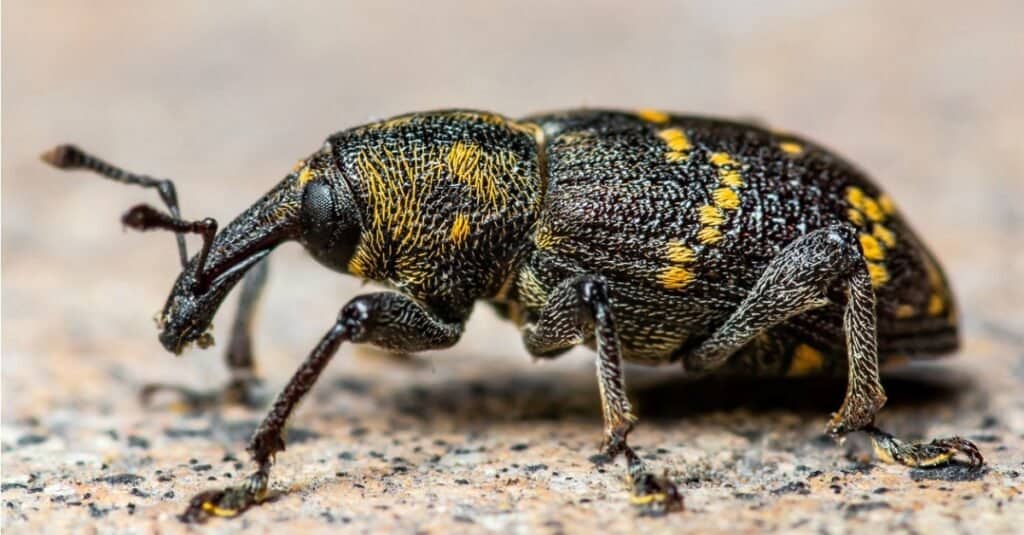
Weevils are small insects reaching lengths of approximately 0.25 inches.
©iStock.com/nechaev-kon
| Weevils | |
|---|---|
| Scientific name | Curculionoidea (superfamily) |
| Description | Small insects reaching roughly 0.25 inches long; are considered pests in many parts of the world. |
| Jumping possibilities | They use their hind legs to jump |
| Another unique feature | Elongated snouts |
Weevils are small insects reaching lengths of approximately 0.25 inches. However, since our planet hosts over 97,000 weevil species, it would be almost impossible to highlight an accurate description of this superfamily of insects!
What we can say, however, is that weevils can jump! Very little is known about the weevil jumping mechanism, though, as studies focus only on specific species, which isn’t enough to make a general, scientifically accurate statement about how far weevils can jump. However, one thing is certain: as per this study, weevils use their hind legs for jumping by extending their hind tibias.
Summary of 10 Commonly Found Bugs That Jump
| Name of Bug | Jumping Features |
|---|---|
| Flea | Can jump 50 times their body length. |
| Ant | Often jump during foraging or if they feel agitated. |
| Lacewing | Jump through simultaneous propulsive movements made by two pairs of legs, |
| Treehopper | Have specialized muscles on the hind femora that produce power for jumping. |
| Cricket | The hind legs are enlarged to allow jumping. |
| Thrip | Small, light bodies allow them to crawl, walk, or jump. |
| Grasshopper | Can jump distances of up to 3.2 feet. |
| Leaproaches | Have enlarged hind legs that provide jumping power |
| Jumping Plant Lice | Have small hind legs that provide great jumping power, |
| Weevil | Use the hind legs to jump by extending the hind tibias. |
The photo featured at the top of this post is © iStock.com/tri mintarjo
Sources
- Planet Natural Research Center, Available here: https://www.planetnatural.com/pest-problem-solver/tree-pests/psyllid-control/
- Entomology, University of Kentucky, Available here: https://entomology.ca.uky.edu/ef413
Thank you for reading! Have some feedback for us? Contact the AZ Animals editorial team.






